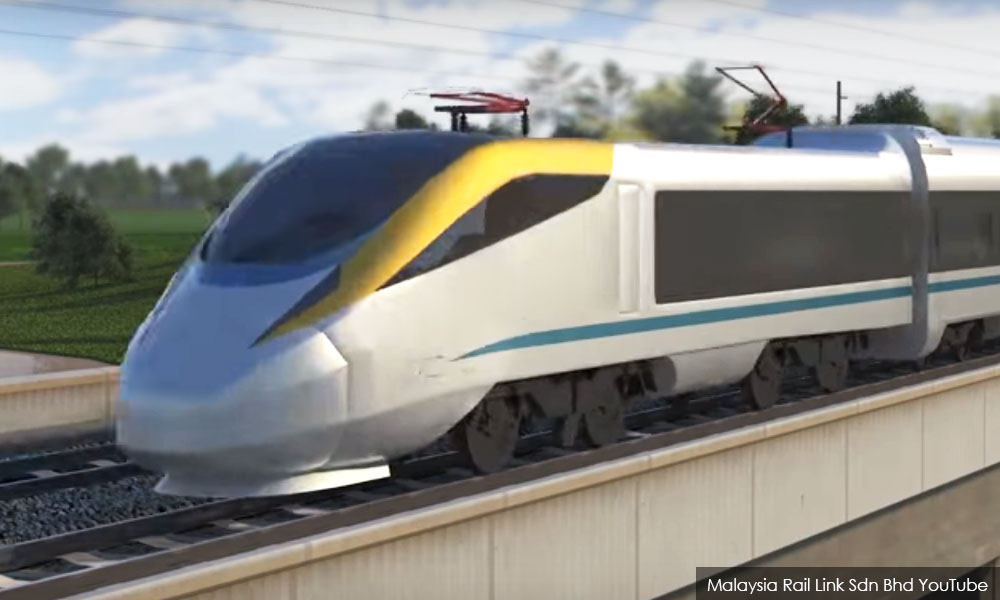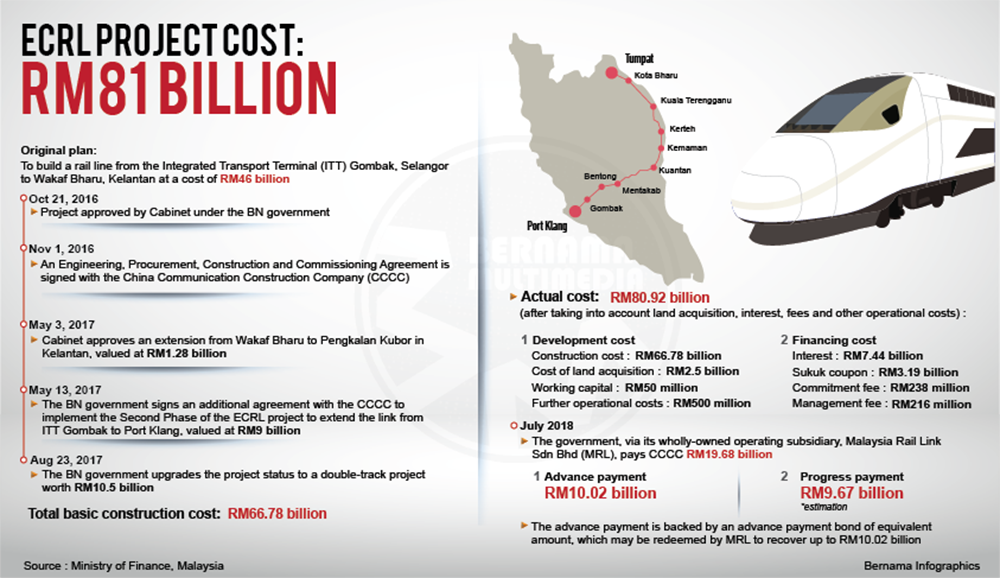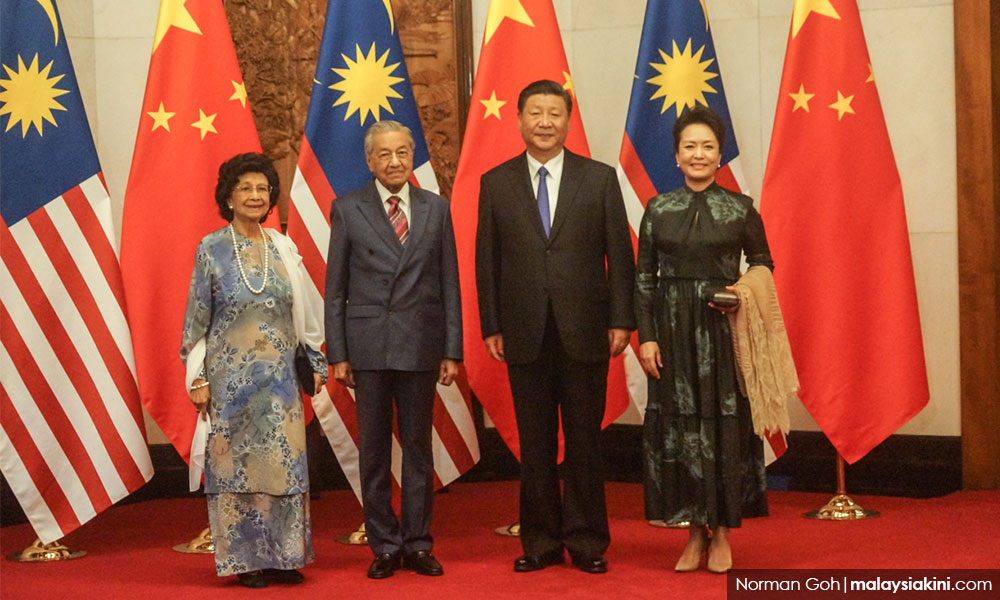
QUESTION TIME | Recently Prime Minister Dr Mahathir Mohamad talked about a resumption of the RM81 billion East Coast Rail Link or ECRL, albeit at a specified lower cost. But it will be a very bad mistake if that is done simply because we don’t need it.
First, some background. The original cost of the project when first announced was RM55 billion but that was for the stretch from Gombak to Kota Baru and does not include the Gombak to Port Klang stretch. This was estimated by the new Pakatan Harapan government to cost a further RM11 billion, to make construction costs alone RM66 billion. (See table below for details of the project.)
It was envisaged that viability would be ensured by transhipping traffic between Port Klang and Kuantan to avoid the circuitous route around the Malay peninsula for trade between east and west. But figures indicate you need very large amounts of trade to make this feasible.
And then there are other costs such as rolling stock, land acquisition and financing during construction,all of which, according to Finance Minister Lim Guan Eng, pushes the cost up to a massive RM81 billion.
I did some back-of-envelope calculations for feasibility in a previous column. Currently, KTM transports just six million tonnes per year and its revenue is estimated at no more than RM600 million in 2017, which gives an average transport charge, ignoring passengers, of RM100 a tonne.
If we use this figure for ECRL, 53 million tonnes will give it revenue of RM5.3 billion for freight or RM7.6 billion in total, assuming the given ratio of 70 percent freight to 30 percent passenger for revenue. A 20 percent margin on this gives an income of RM1.5 billion. The impossible task ahead is illustrated by this: In 2017, Singapore’s port had a turnover of S$3.97 billion (RM12 billion) and a profit of S$1.3 billion (RM5.2 billion).
Even if we use the original given cost of RM55 billion and 10 percent return for a required income of RM5.5 billion, the RM1.5 billion figure is just 27 percent of that. If we use the RM81 billion and a 10 percent required rate of return or RM8.1 billion, the RM1.5 billion is just 19 percent of that.
Will it at least pay for interest costs and repayment of the loan? No. Our calculations indicate that at the end of seven years of grace period from repayment, the loan amount of 85 percent or RM46.75 billion would have gone up to RM58 billion at an annual interest rate of a compounded 3.25 percent. Thereafter, loan repayments on the RM58 billion over 20 years amount to just under RM4 billion a year. Income of RM1.5 billion is only 37.5 percent of repayment, short by RM2.5 billion a year when repayment starts.

These figures are enough to show that very major adjustments, which are unlikely to be made, are necessary before the project can come anywhere near feasible. Even Mahathir said last August that the government had received offers for construction of the ECRL for just RM10 billion! That is a massive RM45 billion less than what the Chinese are charging.
Inflated cost
These figures indicate something was very wrong with the entire project. It was not only unviable, but massive corruption also took place by systematic over-pricing, which was deliberately built into the system.
On top of that, there were clear indications that the ECRL deal was done partly to rescue 1MDB, which had a hole of at least RM30 billion in its accounts. Mahathir himself said in an interview with The Edge in early June last year, soon after becoming prime minister, that the loan for Malaysia to build the ECRL is being kept abroad, adding that this led to suspicions that some of the money was used to repay 1MDB debts and to buy certain companies.
Mahathir also confirmed that there were suspicions that some money paid for the ECRL was to be used to retire 1MDB’s debts and to buy certain companies and that his government intended to review and renegotiate the terms of the project with the various Chinese parties.
Quoting sources, The Edge reported in the same article that the cost of the ECRL project was inflated by about RM20 billion, in part to buy assets from 1MDB.
Reports said payment was to be made directly to China Communications Construction Co Ltd (CCCC) without the money coming into Malaysia according to schedule, which does not reflect payment on a percentage of completion basis. Apparently, RM20 billion had already been drawn down from the loan, but there is no clarity till today on where the money has gone.

If Mahathir now sweeps all of this under the carpet and does a deal with China, which still makes things profitable to them, he will be doing the country a great disservice. Any resumption of the ECRL must be done only after full details of the project are given in the interest of transparency and accountability. Otherwise, it would be condoning corruption on a massive scale.
Instead of leaving negotiations to people like Daim Zainuddin, the government through the Finance Ministry should be directly involved and nothing should be hidden. If it is necessary to take China to the international courts to obtain just compensation, so be it.
Finance Minister Lim Guan Eng said if the project is not continued, the maximum payment that cannot be recovered is around RM10 billion. That would probably be cheaper than continuing with an unviable project which will drain the country’s resources for decades. According to him, the government has paid RM20 billion of which about half is recoverable.
It is necessary to realise that China may have been complicit in criminal activities, which include conspiring in arrangement to cover up the 1MDB hole by agreeing to over-priced contracts. It is important that the attorney-general’s advice and input are sought to see if the contract can be negated on the grounds that criminality was involved. We should not so easily give in to China but must seek a just settlement for ourselves.
Otherwise, we will end up with a needless infrastructure project which will handicap us for years to come, such as the RM36 billion double-tracking project - only much worse - started during the previous Mahathir administration (which ended 14 years ago in 2003) and which is considerably underutilised and making losses to this day.
P GUNASEGARAM says infrastructure should be based on need and affordability, nothing else. E-mail: t.p.guna@gmail.com - Mkini


No comments:
Post a Comment
Note: Only a member of this blog may post a comment.